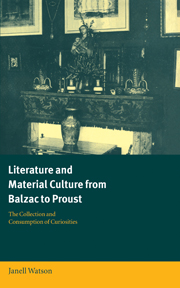Book contents
- Frontmatter
- Contents
- Acknowledgments
- Introduction
- Chapter 1 The bibelot
- Chapter 2 The logic(s) of material culture
- Chapter 3 The fashionable artistic interior
- Chapter 4 Flaubert's “musées reçus”
- Chapter 5 Narrate, describe, or catalogue?
- Chapter 6 The parlour of critical theory
- Chapter 7 Rearranging the Oedipus
- Notes
- Bibliography
- Index
- CAMBRIDGE STUDIES IN FRENCH
Chapter 5 - Narrate, describe, or catalogue?
The novel and the inventory form in Balzac, the Goncourts, and Huysmans
Published online by Cambridge University Press: 22 September 2009
- Frontmatter
- Contents
- Acknowledgments
- Introduction
- Chapter 1 The bibelot
- Chapter 2 The logic(s) of material culture
- Chapter 3 The fashionable artistic interior
- Chapter 4 Flaubert's “musées reçus”
- Chapter 5 Narrate, describe, or catalogue?
- Chapter 6 The parlour of critical theory
- Chapter 7 Rearranging the Oedipus
- Notes
- Bibliography
- Index
- CAMBRIDGE STUDIES IN FRENCH
Summary
The various middle and upper classes of late nineteenth-century Paris become increasingly accustomed to consulting catalogues, of museums, of art auctions, of estate sales, and of the new department stores. It is no coincidence that this proliferation of catalogues coincides with the proliferation of the bibelot and other material goods in the home and in the marketplace. This culture in the grips of rationalizing bureaucratization perceives a need to inscribe in writing its new material abundance. The catalogue form evolves out of the simple inventory, the written accounting of material accumulation, a representational tool invented by merchants and adopted by collectors of curiosities, antiquarians, and museographers. As the bibelot invades the novel, taking up more and more space in the body of the text, it brings with it the catalogue form, a form of writing born of the profane sphere of material culture, not the sanctified sphere of “literary” writing. However, while mainstream literature assimilates the catalogue form during the nineteenth century, mainstream literary criticism does not embrace the literary catalogue until the advent first of poststructuralist then of postmodernist literary criticism. The divergence of the critics reveals much about the literature itself.
- Type
- Chapter
- Information
- Literature and Material Culture from Balzac to ProustThe Collection and Consumption of Curiosities, pp. 109 - 142Publisher: Cambridge University PressPrint publication year: 2000

